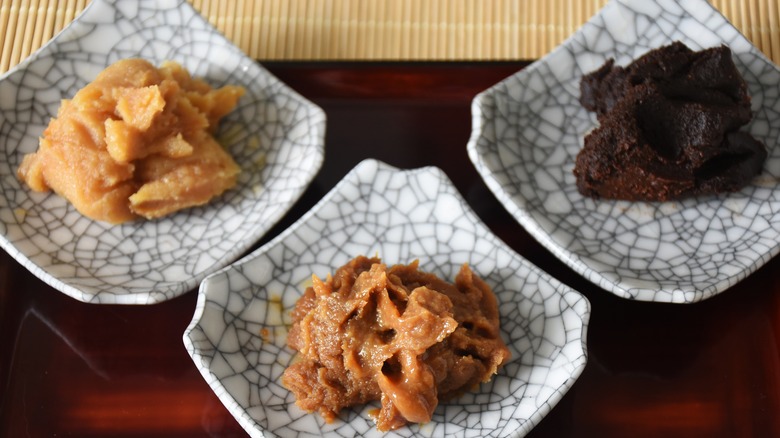Miso Is The Missing Ingredient In Your Tuna Noodle Casseroles
Often maligned, sometimes adored, tuna casserole is a dish that, for its humble appearance, is sure to make a splash at the dinner table. The casserole (or hot dish, if you're from Minnesota) is simple enough — consisting of canned tuna, canned cream of mushroom soup, peas, noodles, and bread crumbs. It is an icon of hodgepodge mid-century cooking, which puts convenience above all else. But despite this, tuna casserole has become a nostalgic treat for many. However, this does not mean that tuna casserole needs to be bound by its relatively ho-hum reputation.
In fact, there is one ingredient that can level up your tuna dish game: Miso. Now, adding miso to this dish may seem to be nonsensical. But you might want to reconsider. After all, it is a delicious and umami-heavy ingredient known to enhance many dishes (including the creamy cousin of tuna casserole, tuna salad). Miso is a paste made of soybeans (and other ingredients such as rice or barley) that have been fermented, and is often used in soups, dips, and baked goods such as cookies. It comes in several varieties, each with varying flavors, but generally has a salty, rich flavor that can enhance other ingredients. Adding miso to the soupy base of tuna casserole can add much needed depth to the dish without sacrificing convenience.
How to incorporate (and highlight) your miso
While plopping in a dollop of miso is an easy (and great) addition to your usual tuna casserole recipe, it might be a good idea to update a few other aspects of your recipe to fit the miso-infusion. Some recipes calls for a bullion base to the casserole rather than the traditional soup base. This addition can add richness that will complement your miso. You can also swap out the usual addition of a bread crumb topping with crushed potato chips. This will add heartiness and richness to your dish that takes it beyond its usual, creamy texture. Now, if you really want to lean into the umami flavors of miso, you can also top your casserole with crumbled seaweed flakes.
Now, when it comes to actually incorporating your miso, there are a few things you should consider. You can add in as much or as little miso as you please. However, for a large dish of casserole, adding about a half cup of miso in with your cream cheese and soup (or bouillon) base should be enough to add a distinct flavor without overpowering the dish. However, you can test out different amounts and adjust as needed.
What miso to use
Ok, so miso makes a great add-in to tun casserole. But what type works best? After all, there are several varieties to choose from, each with a different flavor profile and level of intensity. A darker variety, such as red miso, might be too intense for this dish, as it is very salty and complex thanks to its longer fermenting time. Red miso works best for adding to marinades and stews rather than for the creamy casserole. For the tuna dish, it's best to stick with either white or yellow miso.
If you're a little miso-shy, adding white might be a smart bet. White miso is the least intense of all the varieties, and has a much more subtle flavor profile. It can have a bit of a sweet taste, which can help complement the creaminess of the dish, while also adding a touch of umami. If you're hoping for more of an intense punch of flavor, you can always add in yellow miso, which sits somewhere in between white and red in terms of intensity. Yellow has a sharper taste than white miso, which can add punch to your hot dish, while also bringing the same savory flavor as the lighter version. It does have more of a sour taste, so if you're looking for a strictly creamy casserole, you might want to opt for white.


